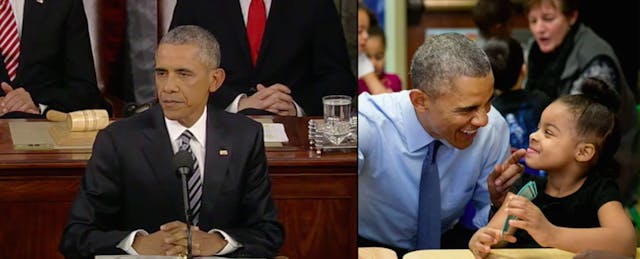President Obama gave his final State of the Union address the evening of January 12.
Among other things, he advocated for bipartisanship and a recognition of climate change science. He also mentioned the word "education" four times, according to the full transcript of his speech*.
In a teasing forecast, Obama said, “But tonight, I want to go easy on the traditional list of proposals for the year ahead. I’ve got plenty, from helping students learn to write computer code to personalizing medical treatments for patients.” The White House is bullish on computer science, but we’ll have to wait to see the specifics of how that takes shape.
Touching implicitly on the major societal shifts the Internet has brought about, Obama talked about the “extraordinary change” shaping our world today without mentioning the web. He said the today's change “promises education for girls in the most remote villages, but also connects terrorists plotting an ocean away.” Along the lines of girls’ education, Obama referred to both “teacher” and “student” with female pronouns.
When highlighting his successes in education, the president noted increases in students accessing the Internet and the record rise in high school graduation rates, publishing the graph below as part of the full text of the speech.

In addition to overall graduation rates, the president hailed a boost in engineering graduates. To emphasize the importance of those fields, he drew the connection between STEM fields and well-paying jobs that undergirds much of STEM advocacy:
“We agree that real opportunity requires every American to get the education and training they need to land a good-paying job,” Obama said. “The bipartisan reform of No Child Left Behind was an important start, and together, we’ve increased early childhood education, lifted high school graduation rates to new highs, and boosted graduates in fields like engineering.”
Obama's praise of the work of No Child Left Behind is a nod towards the Every Student Succeeds Act (ESSA)—otherwise known as the rebranded and reauthorized No Child Left Behind. Early childhood education, particularly for marginalized and low-income populations, was a focus of the old act and continues to be a priority for the new one.
“In the coming years,” President Obama said, “We should build on that progress by providing Pre-K for all, offering every student the hands-on computer science and math classes that make them job-ready on day one, and we should recruit and support more great teachers for our kids.”
Obama also argued for more STEM classes, which the ESSA supports. He pushed for the expansion of almost everything he talked about. There are two notable things he argued for the shrinking of, though: ISIS and student loan debt. This year, he tied one of them to community colleges.
“We’ve already reduced student loan payments to ten percent of a borrower’s income. Now, we’ve actually got to cut the cost of college. Providing two years of community college at no cost for every responsible student is one of the best ways to do that, and I’m going to keep fighting to get that started this year.”
Obama has advocated for the expansion of community colleges in State of the Union addresses before. The legislation may be on its way after several addresses championing the benefits of community colleges. It remains to be seen if he can rally support for the initiative, which some experts have called “bad for poor Americans.”
Notable Plus Ones
First Lady Michelle Obama invited a slew of guests, several of whom work towards goals aligned with the President’s education initiatives. In the First Lady’s box were a community college student, a young STEM education advocate and a renowned robotics teacher who immigrated from Mexico. Microsoft CEO Satya Nadella also attended, and his bio on the White House’s blog promotes Microsoft’s $75 million pledge to youth computer science education.
Senator Elizabeth Warren invited University of Massachusetts Lowell student Alexis Ploss, a math major who took out $50,000 in student loans to pay for her undergraduate degree and plans to earn a master’s degree to become a public school teacher. Senators Tammy Baldwin (D-WI) and Chuck Schumer (D-NY) also invited guests with significant student loan debt.
“Rising student loan debt is crushing America's young people and limiting their long-term opportunities,” Warren told Politico. “Our country should be encouraging students like Alexis.”
Rep. Mike Bishop (R-MI) was accompanied by his high school history teacher, Greg Clevenger. Bishop said the man inspired him to major in history.
Speaker of the House Paul Ryan (R-WI) did his utmost not to laugh, and seemed unimpressed with the whole affair. His team was tweeting throughout the speech, and in the middle of the address, he sent his supporters an email. He pushed back on many of Obama’s points, framing the Every Student Succeeds Act as a reclamation of power from the federal government, and dismissed the first 30 minutes of the speech as “lofty platitudes and nostalgic rhetoric.” Ryan invited Logan Barritt, a Wisconsin 4-year-old who started sending care packages abroad to soldiers after learning about them in school. Ryan’s mid-speech email extolled his party’s work to boost military funding.
The End
President Obama ended his speech by invoking the image of hardworking Americans in the classroom: “I see your quiet, sturdy citizenship all the time...I see it in the Dreamer who stays up late to finish her science project, and the teacher who comes in early because he knows she might someday cure a disease.”
This, he said, is the reason the state of our union is strong.
*Accompanied by a bingo board.


